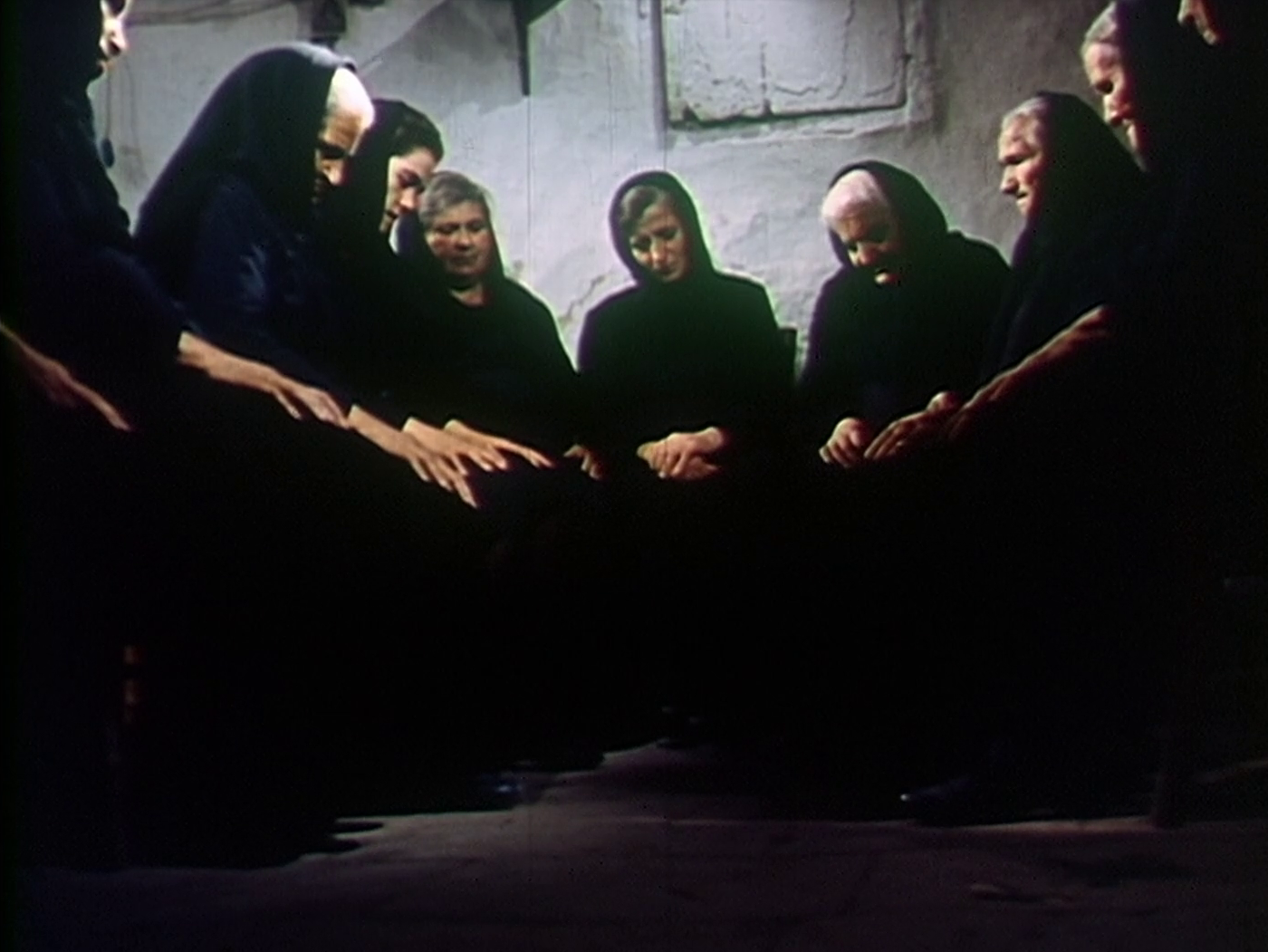
Shot in Martano, Stendalí is the record of a female mourning ritual – enacted within ethnic Greek communities that spoke Griko, a dialect that can still be found in southern Puglia – on the brink of extinction. When Mangini arrived in the town in 1960, she could find only two women who remembered fragments of the chants; they told her, “When we are gone, the lamentations will be gone, too.” Despite its observational style – albeit sped up in the edit, sometimes to comical effect – the film is in fact entirely reconstructed and restaged. Believing funeral chants to be one of the highest forms of poetry, Mangini entrusted Pasolini to work with the two women’s memories to create a Griko “replica” and to write a narrated script in Italian, voiced by actress Lilla Brignone. The addition of voice-over meant that Mangini didn’t have to choose between integrating Italian translation or subtitles, which she believed would disrupt the rhythm of the songs and the relationship between sound and image (Daniella Shreir).
EN
Gianluca Sciannameo: Are all the events in your documentaries staged? How much of what’s recorded on camera was still happening at the time? What elements did you choose to foreground in your cinematographic renditions of the ritualistic?
Cecilia Mangini: The events in Stendalì, La passione del grano and L'inceppata are all staged – or rather, re-staged, after much research and careful study, in which we foregrounded the elements of stylisation that are central to all rituals. Were those rituals still ongoing? Of all the Greek-speaking villages in Salento, mourning lamentations persisted only in Martano, as a tradition whose last repositories were the women we captured on film, playing themselves. The women were aware of this, so much so that they told me: ‘When we are gone, the lamentations will be gone, too.’ Whether they still practiced it? I’m not sure, but I imagine they would have as a last salute to Nunziata and Filomena, the oldest among them. The same goes for La passione and L’inceppata – although really an ethnologist should have the last word on these matters. The idea I got was that the elders in these communities would had been ‘defending themselves from the malignant threats of daily life’ by such things as performing lamentations, the sickle ritual, or the ritual of the engagement log. Their children would have witnessed these rituals often enough to memorise them before they disappeared, joining in only occasionally. Their grandchildren only had a vague, ghostly memory of them. Their great-grandchildren will have forgotten them entirely. It’s hard to pinpoint the exact time of death of magic rituals. Its killers, however, are known: television, the social state and consumerism.
Cecilia Mangini in conversation with Gianluca Sciannameo1
“Mangini allows us to listen to voices as they show emotion and to see, up close, faces in both joy and pain. In many of her documentaries about the South and the quickly disappearing traditions found there, she collaborated with Pasolini, working together to build a tangible and unmistakable poetic. I cannot stop thinking about the fact that Pasolini wrote the lamentations we hear in Stendalì: suonano ancora (1960), another film on which they collaborated. He based the song, in Griko, a dialect of Greek spoken in Salento, off remnants the women featured in the film could remember, and which had been passed along through generations going back to the 1800s. And yet, while they may feel authentic to the outsider, these are reconstructions; in this film Mangini used a professional actress, Lilla Brignone, to lead the song. But still the women’s cries conjure up past traumas – the crying is part of traditional women’s ritual, the gendered work of mourning. Despite the documentary being staged, the cries from the mourners excavate something deep, powerful, intergenerational. Pasolini the poet and Mangini the image-maker tap into ancient traditions found not in the specifics of the language but in the manner in which the body produces such sounds. I think of Dante in ‘Canto XIII’ of La Vita Nuova, longing to be with Beatrice as she mourns the death of her father; he is told to go away, to stay outside of the house, ‘in keeping with the customs of the city mentioned earlier, women with women and men with men come together on such sad occasions, many women gathered where this Beatrice was weeping pitifully…’. Harnessing this ancient form, Mangini and Pasolini show us something that has always been a part of us.”
Allison Grimaldi Donahue2
- 1Gianluca Sciannameo, “An Interview with Cecilia Mangini,” Another Screen, 2021. Originally published in Nelle indie di Quaggiù. Ernesto de Martino e il cinema etnografico (Bari: Palomar, 2016). Translated from Italian by Livia Franchini.
- 2Allison Grimaldi Donahue, “Finding the Real in the Magic: What Cecilia Mangini Gave Us,” Another Screen, 2021.
FR
« Un groupe de femmes vêtues de noir pleure un jeune défunt : la lamentation fait partie d’un rituel bien précis. Il s’agit de l’unique témoignage cinématographique de l’ancien rite, désormais disparu, du chant funèbre en griko, inspiré de la leçon du cinéma soviétique d’avant-garde et des œuvres de l’ethnologue Ernesto De Martino. Une « mise en scène » de la réalité à l’impact visuel et sonore extraordinaire, obtenu en ébranlant l’objectivité du plan fixe et en multipliant les points de vue et les détails. Le montage pressant accompagne l’intensité du rituel dans un crescendo tourbillonnant, entrelaçant les images, les paroles du commentaire signé par Pier Paolo Pasolini et l’extraordinaire bande originale composée par Egisto Macchi. Des visages comme des pierres, des gestes très anciens et l’exorcisme de la mort donnent vie à un tableau sans égal dans le cinéma documentaire contemporain. Ici, la forme visuelle baigne dans le rituel, prend son apparence, absorbe la charge émotionnelle du texte écrit par Pasolini. »
Marina Mazzotti1

